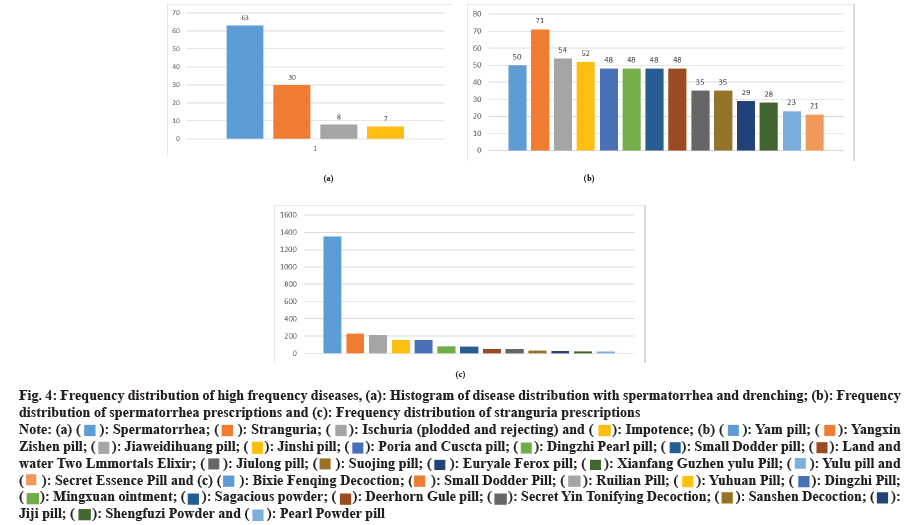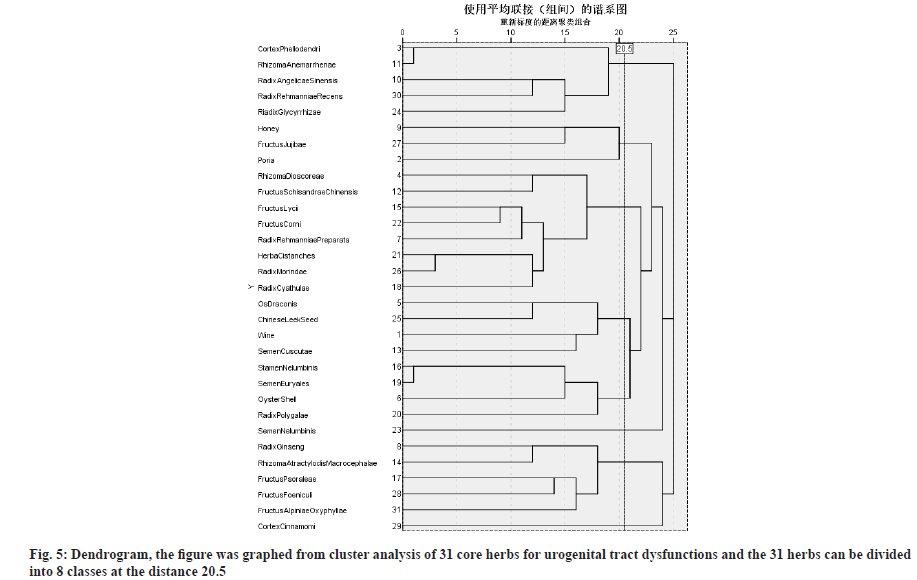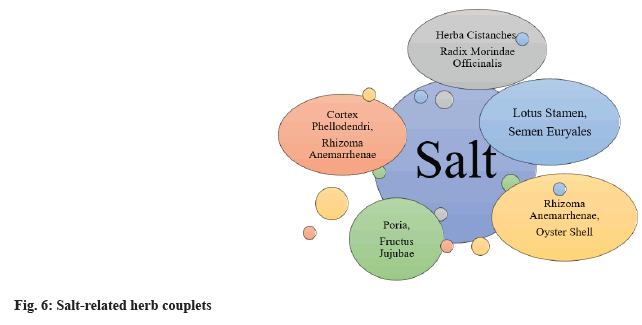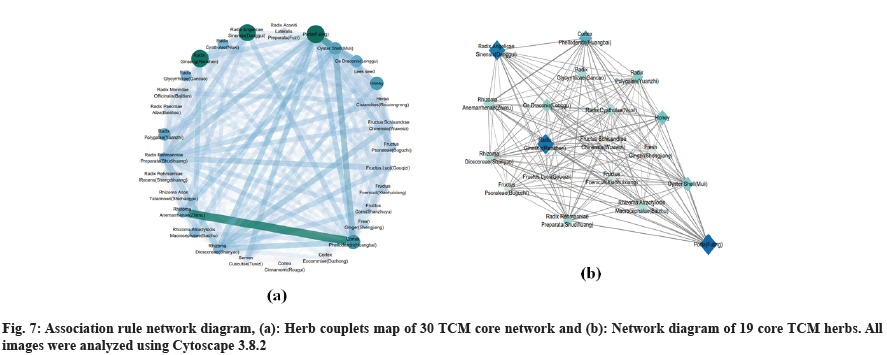- *Corresponding Author:
- Lina Xia
Key Laboratory of Traditional Chinese Medicine Regimen and Health Industry Development, State Administration of Traditional Chinese Medicine, Chengdu, Sichuan 610075, China
E-mail: xialina@cdutcm.edu.cn
| This article was originally published in a special issue, “Current Trends in Pharmaceutical and Biomedical Sciences” |
| Indian J Pharm Sci 2022:84(5) Spl Issue “328-336” |
This is an open access article distributed under the terms of the Creative Commons Attribution-NonCommercial-ShareAlike 3.0 License, which allows others to remix, tweak, and build upon the work non-commercially, as long as the author is credited and the new creations are licensed under the identical terms
Abstract
To analyze the rules of salt-related traditional Chinese medicine herbal formulas of urogenital dysfunctions using data mining, the results could provide novel prescriptions and give suggestions to clinical application. The data mining methods used in this study including frequency analysis, cluster analysis and association rule. A total of 108 formulas involving 141 herbs were included in this study. The most frequently used herb is Poria (Fuling). The top three categories were deficiency-tonifying herbs (34.07 %), astringent herbs (11.85 %) and emetic herbs (10.09 %). The properties of the herbs were mainly being warm (403), cold (334) and calm (304). The tastes of the herbs were mainly sweet (699) and bitter (316). The main meridian tropisms were kidney meridian of foot-shaoyin (726), liver meridian of foot-Jueyi (418), spleen meridian of foot-Taiyin (406). The main formulas for spermatorrhea are Yangxin Zishen pill (71). The top two formulas of stranguria were Bixie Fenqing decoction (1354). According to the cluster analysis, the high-frequency herbs were divided into 8 salt-related categories. According to association rule analysis, 16 common salt-related couplets medicines were obtained. The treatment of urogenital dysfunctions is mostly clearing, tonifying and astringing methods. The law of medicines compatibility and the application of meridian ushering herbs have high reference value for the clinical treatment of urogenital dysfunctions.
Keywords
Data mining, urogenital system, kidney, homeostasis
It is estimated that Urogenital Dysfunctions (UD) accounts for approximately 10 % of all trauma patients and the kidney is the most severely damaged genitourinary organ globally[1]. The management of UD aims to restore homeostasis and normal physiology where non-operative management is considered the golden standard[2]. A variety of Traditional Chinese Medicine (TCM) herbals have shown protective effects against UD. In the basic theory of TCM, urogenital system is closely related to kidney, kidney stores essence, Yin and Yang. Kidney being innate foundation, therefore, it is the basis of human growth, development and reproduction. The decline of kidney essence function will lead to seminal emission and premature ejaculation. As a result of inadequacy of healthy Qi, debilitation of the fire of life gate and affect the reproductive ability, bring about impotence and infertility. From TCM viewpoint, UD is mainly reflected in spermatorrhea, stranguria, ischuria, anuria and vomiting, impotence, etc.
Salt has salty flavor, cold property, salty flavor enters the kidney meridian of foot-Shaoyin. The treatment of salt in classical books is mainly used in kidney diseases. Salt is a kidney tonic and can prolong life. According to TCM, take kidney-supplementing decoction with salt, the function of salt is to conduct TCM herbals into the kidney meridian of foot-Shaoyin. Adhering to this principle, later physicians usually use salt to introduce medicinal property into the kidney meridian to treat kidney related diseases. TCM classifies UD as kidney disease system. Therefore, salt has a strong correlation with UD. This paper focuses on the regulation of saltrelated TCM herbal formulas in the treatment of UD.
The Chinese Medical Code on CD-ROM (5th edition) is an electronic series of classical books of TCM compiled by Hunan electronic audio-visual publishing house. According to the library classification, 1156 classical books are classified into 12 categories including medical classics, diagnostic methods, herbal foundation, remedy books, acupuncture, moxibustion and tuina. In our study, the comprehensive medical book in the Chinese medical code was selected as the data mining source. The comprehensive medical book database included in this research contains 87 classic classical books. It has a comprehensive record on the treatment of UD. As an advanced information processing technology of the cross fusion of artificial intelligence and database, data mining can reflect the mutual mapping relationship between multidimensional data. Data mining is an interdisciplinary field that extracts knowledge and insights from many structural and unstructured data, using scientific methods, machine-learning algorithms[3]. In recent years, the overall literature of TCM data mining is on the rise[4]. TCM data mining method that gets increasing attention is the quantitative research method, which makes use of data mining and artificial intelligence technology and academic viewpoints of dialectical treatment by TCM, clinical technology of TCM, the patterns of TCM prescriptions, clinical effects of TCM[5,6]. This article is based on the cross-screening, the salt-related prescriptions containing treatment of UD in the comprehensive medical book were obtained and the medication rules were analyzed.
Materials and Methods
Collection of data:
The prescription came from the comprehensive medical book database of the Chinese medical code published by Hunan electronic audiovisual publishing house (5th edition). The search terms are "salt", "salty flavor", "strangury", "spermatorrhea", "ischuria" and "impotence". A total of 108 formulas, 141 TCM herbals, were collected and included after investigation and inclusion from 7639 articles. The data will be imported into Microsoft Excel 2019 to establish the database and then converted into the data that can be recognized by statistical software for statistical analysis after standardized reduplication. Through computer retrieval database, screening and inclusion were carried out by reviewing catalogue of classical books and reading articles. The detailed workflow diagram is summarized in fig. 1.
Data process:
The collected 108 formulas were tabulated by Microsoft Excel 2019. The herb names in the original literature were standardized according to Chinese pharmacopoeia (2020 edition) and Chinese Materia Medica. We followed the methods of Yang et al.[7].
Data statistical analysis:
IBM Statistical Package for the Social Sciences (SPSS) Statistics 26.0 software was used to calculate the frequency of high-frequency core herbs use in the prevention and treatment of UD. The Apriori algorithm developed by Institute of Chinese Medicine Information-Chinese Academy was used to association rules learning. IBM SPSS Statistics 26.0 software was used for hierarchical clustering of core herbs.
Results and Discussion
In this study, a total of 108 prescriptions and 141 herbs were collected according to screening, with a total frequency of 1080 times. TCM herbs with high frequency (>14) are 21, 10 of which are TCM with a frequency greater than 20 %. They were Poria (Fuling) 49 times, Cortex Phellodendri (Huangbai) 34 times, Rhizoma Dioscoreae (Shanyao) 30 times, Dragon bones (Longgu) 29 times, Concha Ostreae (Muli) 29 times, cooked Rehmanniae (Shudihuang) 26 times, Radix Ginseng (Renshen) 25 times, Chinese angelicae (Danggui) 23 times, Anemarrhena (Zhimu) 23 times, Schisandra (Wuweizi) 22 times. It can be seen from Table 1 that all high-frequency TCM herbs are mostly attributed to the kidney meridian of foot-Shaoyin, with warm and mainly sweet and bitter flavor. The TCM herb with the highest frequency is Poria (Fuling). Study has shown that large dose Poria (Fuling) will systematically evaluate the effectiveness and safety intervention for people with diabetic nephropathy[8]. It shows the overall classification of all TCM herbs in UD treatment, as well as the proportion of the number and frequency of use of all herbs in the total number in fig. 2. The highest frequency was deficiency-tonifying herbs (368 times, 34.07 %). The frequency of astringent herbs was 128 times, accounting for 11.85 %. The third is emetic herbs, the frequency is 109 times, accounting for 10.09 %. The fourth is heat-clearing herbs; frequency is 86 times, accounting for 7.96 %.
| No. | Herb name | Frequency (n) | Rate (%) |
|---|---|---|---|
| 1 | Poria | 49 | 45.37 |
| 2 | Cortex Phellodendri | 34 | 31.48 |
| 3 | Rhizoma Dioscoreae | 30 | 27.78 |
| 4 | Dragon Bone | 29 | 26.85 |
| 5 | Concha Ostreae | 29 | 26.85 |
| 6 | Cooked Rehmanniae | 26 | 24.07 |
| 7 | Radix Ginseng | 25 | 23.15 |
| 8 | Chinese Angelicae | 23 | 21.3 |
| 9 | Anemarrhena | 23 | 21.3 |
| 10 | Schisandra | 22 | 20.37 |
Table 1: The Frequencies of Core Medicinal Materials in Prescriptions
Fig. 2:Action categories of 141 herbs
Note: ( ): Deficiency-notifying herbs; (
): Deficiency-notifying herbs; ( ): Hemostatic herbs; (
): Hemostatic herbs; ( ): Blood-activating and stasis-eliminating herbs; (
): Blood-activating and stasis-eliminating herbs; ( ): Wild-damp dispelling
herbs; (
): Wild-damp dispelling
herbs; ( ): Interior-warming herbs; (
): Interior-warming herbs; ( ): Tranquilizing herbs; (
): Tranquilizing herbs; ( ): Vermifugal herbs; (
): Vermifugal herbs; ( ): Qi-regulating herbs; (
): Qi-regulating herbs; ( ): Heat-clearing herbs; (
): Heat-clearing herbs; ( ):
Superficies-relieving herbs; (
):
Superficies-relieving herbs; ( ): Astringent herbs; (
): Astringent herbs; ( ): Phlegm-Dissolving and cough-asthma-relieving herbs; (
): Phlegm-Dissolving and cough-asthma-relieving herbs; ( ): Dampness-draining diuretic
herbs; (
): Dampness-draining diuretic
herbs; ( ): Liver-wind calming herbs; (
): Liver-wind calming herbs; ( ): Emetic herbs and (
): Emetic herbs and ( ): Orifice-opening herbs
): Orifice-opening herbs
As fig. 3a shows, the medicines properties were mainly being cold, cool and warm. We adopted five flavors for analysis; pungent, sweet, sour, bitter and salty. As shown in fig. 3b, the distribution of the five flavors was as follows; sweet (699 times), bitter (316 times), pungent (283 times), salty (204 times), astringent (129 times) and sour (102 times). Sweet taste has the effect of nourishing, harmonizing and moistening. Bitter taste has the effect of clearing heat, detoxifying and down bearing fire. This shows that the habit of using medicine pays attention to notify the kidney and clear heat in the treatment of UD. The theory of meridian tropism plays a key role in the clinical selection of TCM herbs. In this study, a tree chart shown in fig. 3c was used to distribute the meridians according to frequency as follows; kidney meridian of foot-Shaoyin (726), liver meridian of foot-Jueyi (418), spleen meridian of foot- Taiyin (406), heart meridian of hand-Shaoyin (395), lung meridian of hand-Taiyin (370), stomach meridian of foot-Yangming (357), large intestine meridian of hand-Yangming (201) small intestine meridian of hand-Taiyang (123), bladder meridian of foot-Taiyang (76), gallbladder meridian of foot-Shaoyang (45) pericardium meridian of hand-Jueyin (3). The results showed that the therapeutic effect was mainly kidney meridian of foot-Shaoyin, liver meridian of foot-Jueyi, spleen meridian of foot-Taiyin and heart meridian of hand-Shaoyin, which reflects the integrity of TCM treatment.
Through cross screening, the disease distribution in 108 prescriptions was as follows; spermatorrhea 63 times, stranguria 30 times, ischuria (anuria and vomiting) 8 times, impotence 7 times in fig. 4a. It shows that spermatorrhea and stranguria patterns are UD with high frequency of salt use recorded in classical books. Fig. 4b shows the histogram of high frequency diseases with spermatorrhea, with the highest frequency being Yangxin Zishen pill (71 times). Fig. 4c is the histogram of stranguria distribution, in which the Bixie Fenqing decoction with the highest frequency (1354 times).
Fig. 4: Frequency distribution of high frequency diseases, (a): Histogram of disease distribution with spermatorrhea and drenching; (b): Frequency
distribution of spermatorrhea prescriptions and (c): Frequency distribution of stranguria prescriptions
Note: (a) ( ): Spermatorrhea; (
): Spermatorrhea; ( ): Stranguria; (
): Stranguria; ( ): Ischuria (plodded and rejecting) and (
): Ischuria (plodded and rejecting) and ( ): Impotence; (b) (
): Impotence; (b) ( ): Yam pill; (
): Yam pill; ( ): Yangxin
Zishen pill; (
): Yangxin
Zishen pill; ( ): Jiaweidihuang pill; (
): Jiaweidihuang pill; ( ): Jinshi pill; (
): Jinshi pill; ( ): Poria and Cuscta pill; (
): Poria and Cuscta pill; ( ): Dingzhi Pearl pill; (
): Dingzhi Pearl pill; ( ): Small Dodder pill; (
): Small Dodder pill; ( ): Land and
water Two Lmmortals Elixir; (
): Land and
water Two Lmmortals Elixir; ( ): Jiulong pill; (
): Jiulong pill; ( ): Suojing pill; (
): Suojing pill; ( ): Euryale Ferox pill; (
): Euryale Ferox pill; ( ): Xianfang Guzhen yulu Pill; (
): Xianfang Guzhen yulu Pill; ( ): Yulu pill and
(
): Yulu pill and
( ): Secret Essence Pill and (c) (
): Secret Essence Pill and (c) ( ): Bixie Fenqing Decoction; (
): Bixie Fenqing Decoction; ( ): Small Dodder Pill; (
): Small Dodder Pill; ( ): Ruilian Pill; (
): Ruilian Pill; ( ): Yuhuan Pill; (
): Yuhuan Pill; ( ): Dingzhi Pill;
(
): Dingzhi Pill;
(  ): Mingxuan ointment; (
): Mingxuan ointment; ( ): Sagacious powder; (
): Sagacious powder; ( ): Deerhorn Gule pill; (
): Deerhorn Gule pill; ( ): Secret Yin Tonifying Decoction; (
): Secret Yin Tonifying Decoction; ( ): Sanshen Decoction; (
): Sanshen Decoction; ( ):
Jiji pill; (
):
Jiji pill; ( ): Shengfuzi Powder and (
): Shengfuzi Powder and ( ): Pearl Powder pill
): Pearl Powder pill
Cluster analysis as a widely used method in data mining of TCM. In our study, the statistical software SPSS Statistics 26 was used to analyze the frequency of TCM herbs (>10). Cluster analysis was performed on 31 high-frequency TCM herbs. When the intercept is 25, it is just divided into 3 categories, while when the intercept is 20.5, medication habit of UD can be divided into 8 categories, as shown in fig. 5. In Table 2, there are 8 clustering TCM herbs groups. The composition of C1 is similar to Zhibai Dihuang pill, which can mainly be used to nourish kidney Yin and clear deficiency heat. C2 honey can clear heat and down bear fire, Fructus Jujube (Dazao) invigorates spleen and tonify Qi, Poria (Fuling) disinhibits dampness and quiet the heart.
| Cluster | Core herbs |
|---|---|
| C1 | Cortex Phellodendri, Rhizoma Anemarrhenae, Radix Angelicae Sinensis, Radix Rehmanniae Recens and Riadix Glycyrrhizae |
| C2 | Honey, Fructus Jujibae, Poria |
| C3 | Rhizoma Dioscoreae, Fructus Schisandrae Chinensis, Fructus Lycii, Fructus Corni, Radix Rehmanniae Preparata, Herba Cistanches, Radix Morindae and Radix Cyathulae |
| C4 | Os Draconis, Chinese Leek Seed, Wine and Semen Cuscutae |
| C5 | Stamen Nelumbinis, Semen Euryales, Oyster Shell and Radix Polygalae |
| C6 | Semen Nelumbinis |
| C7 | Radix Ginseng, Rhizoma Atractylodis Macrocephalae, Fructus Psoraleae, Fructus Foeniculi and Fructus Alpiniae Oxyphyllae |
| C8 | Cortex Cinnamomi |
Table 2: Clustering Framework for Core Herbs
The composition of C3 formula is similar to Gujing Bushen pill, among which, Radix Morindae (Bajitian) and Herba Cistanches (Roucongrong) warm and tonify kidney yang, Radix Rehmanniae Preparata (Shudihuang), Rhizoma Dioscoreae (Shanyao) and Fructus Lycii (Gouqizi) nourish kidney Yin and boost essence and Fructus Schisandra chinensis (Wuweizi) has astringent effect. The composition of C4 is similar to that of Dragon bone leek soup and Os Draconis (Longgu) has the effect of promoting and contraction, Chinese leek seed can tonify kidney and invigorate Yang and wine is used to aid medicine potential. The composition of C5 is similar to that of Jinsuo Gujing pill, in which Lotus Stamen (Lianxu) and Semen Euryale (Qianshi) secure the kidney and nourish essence, while Oyster Shell (Muli) is astringent. C6 Lotus Seed (Lianzi) enrich the kidney, nourish and calm the mind. C7 in Fructus Alpiniae Oxyphyllae (Yizhiren), Rhizoma Atractylodis Macrocephalae (Baizhu), Fructus Psoraleae (Buguzhi) can supplement kidney yang and boost essence. C8 Cortex Cinnamomi (Rougui) can reinforce fire of life gate and strengthen Yang. Among them, C1, C3, C4 and C5 can provide reference for the composition of novel prescriptions for salt-related UD.
Agrawal et al. proposed the Apriori algorithm, the earliest classical association rule, in 1994[9]. In our study, SPSS modeler 18 statistical software was used to analyze the association rules of the established database of UD based on the algorithm. According to the correlation mining of frequent items, 13 items with support degree greater than 10 and confidence degree greater than 80 were obtained, indicating that there was a strong correlation between UD treatments in classical books. According to the order of support degree, as shown in Table 3, a total of 16 salt-related couplets medicinal were obtained and the first 7 pairs are highly correlated. As shown in fig. 6, the top 7 salt-related herb couplets are; Cortex Phellodendri- Rhizoma Anemarrhenae, Lotus Stamen-Semen Euryales, Rhizoma Anemarrhenae-Oyster Shell, Poria- Fructus Jujubae, Herba Cistanches-Radix Morinda officinalis, Cortex Phellodendri-Oyster Shell, Rhizoma Anemarrhenae-Radix Angelica sinensis. It can be seen that the herb couplets with the most frequent occurrence of salt is Cortex Phellodendri-Rhizoma Anemarrhenae and the combination of Anemarrhenae has the highest frequency.
| No | Latter term | Former term | Support (%) | Confidence (%) | Gain |
|---|---|---|---|---|---|
| 1 | Cortex Phellodendri | Rhizoma Anemarrhenae | 21.3 | 100.00 | 3.18 |
| 2 | Lotus Stamen | Semen Euryales | 15.74 | 82.35 | 4.94 |
| 3 | Rhizoma Anemarrhenae | Oyster Shell Cortex Phellodendri | 13.89 | 80.00 | 3.76 |
| 4 | Poria | Fructus Jujubae | 11.11 | 83.33 | 1.88 |
| 5 | Herba Cistanches | Radix Morinda officinalis | 11.11 | 83.33 | 5.63 |
| 6 | Rhizoma Anemarrhenae | Radix Angelica sinensis Cortex Phellodendri | 11.11 | 83.33 | 3.91 |
| 7 | Cortex Phellodendri | Rhizoma Anemarrhenae Oyster Shell | 11.11 | 100.00 | 3.18 |
| 8 | Rhizoma Anemarrhenae | Cortex Phellodendri Poria | 11.11 | 83.33 | 3.91 |
| 9 | Herba Cistanches | Fructus Schisandrae Chinensis Radix Rehmanniae Preparata | 10.19 | 81.82 | 5.52 |
| 10 | Cortex Phellodendri | Lotus Stamen Oyster Shell | 10.19 | 81.82 | 2.60 |
| 11 | Rhizoma Anemarrhenae | Radix Rehmanniae Preparata Cortex Phellodendri | 10.19 | 90.91 | 4.27 |
| 12 | Rhizoma Dioscoreae | Fructus Schisandra chinensis Radix Rehmanniae Preparata | 10.19 | 81.82 | 2.95 |
| 13 | Radix AngelicaSinensis | Radix Rehmanniae Preparata Cortex Phellodendri | 10.19 | 81.82 | 3.84 |
Table 3: Association Rules of Herbs for UD
Cytoscape 3.8.2 visual analysis software was used to make scatter distribution map of circular layout. As shown in fig. 7a, the strong link is thicker, the link size changes continuously, the upper limit of weak link are 5 and the lower limit of strong link is 12. A total of 13 couplets of strong links can be obtained. It can be seen from the fig. 7b that there are 19 kinds of TCM herbs, among which Poria (Fuling), Rhizoma Dioscoreae (Shanyao) and Radix Ginseng (Renshen) have higher degree and higher correlation with other TCM herbs. The law of its use accords with the basic treatment of UD, which is embodied in notifying and clearing heat.
Huangdi’s internal classic said; “When taken into the stomach, the five flavors enter like respectively, sour enters the Liver Meridian of Foot-Jueyi first; bitter enters the Heart Meridian of Hand-Shaoyin first; sweet enters the Spleen meridian of foot-Taiyin first; pungent enters the lung meridian of hand-Taiyin first; salty enters the kidney meridian of foot-Shaoyin first”. The statement revealed the physiological characteristics of salt attribute to the kidney meridian of foot-Shaoyin. Salt has salty flavor, it enters the kidney meridian, we can know that the medication is mainly attributed to the liver, kidney meridian of foot-Shaoyin from fig. 3, the medicinal properties were mainly being cold and the herbs mainly have sweet flavor, followed by bitter, which all is highly correlated with salt. As we all know the relationship between salt and kidney is mainly reflected in clinical treatment, that is, an appropriate amount of salt nourishes the kidney. In addition, the study calls a high-salt intake is associated with the risk of UD. Salt intake reduction proved an effective way to improve people’s health, either by the right choice of food or by a reduction of added salt[10].
The association rule analysis based on Apriori algorithm showed a total of 16 salt-related herb couplets, reflecting the close relationship between salt and UD. As can be seen the data from Table 3, the closest couplets herbs are Rhizoma Anemarrhenae (Zhimu)-Cortex Phellodendri (Huangbai). Rhizoma Anemarrhenae, which has a long history to be used as a TCM herbal to treat various ailments, like cold impediment, night sweat, Yin-vacuity tidal fever and bone-steaming tidal fever. Modern pharmacology shows that, Rhizoma Anemarrhena asphodeloides has demonstrated a strong potential for therapeutic and health-maintaining purposes[11]. Flavonoids are the main components of the TCM herbal Anemarrhenae Rhizoma (Zhimu). Study have shown that treatment with flavonoids significantly ameliorated Benign Prostatic Hyperplasia (BPH)-associated prostate inflammation and inhibited the expression of Cyclooxygenase-2 (COX-2) and 5-Lipoxygenase (5-LOX) at the protein and messenger Ribonucleic Acid (mRNA) levels[12]. It reflects the correlation between Anemarrhenae Rhizoma (Zhimu) and UD. The medicinal part of Phellodendron is the dried trunk bark. The medicine has comprehensive therapeutic effects which include antiinflammatory, antimicrobial, anticancer, hypotensive, antiarrhythmic, antioxidant and antipyretic agents[13]. Modern pharmacology suggests that the antiinflammatory effective fraction of Anemarrhenae Rhizoma-Phellodendri Chinese Cortex herb couplet was 30 % ethanol elution site, the pharmacophore may protect RAW 264.7 cell damage by inhibiting the Nuclear Factor-kappa B (NF-κB) signaling pathway, inhibiting the expressions of inducible Nitric Oxide Synthase (iNOS), COX-2 and the secretion of related inflammatory factors[14]. And salt preparation of Rhizoma Anemarrhenae (Zhimu) and Cortex Phellodendri (Huangbai) had significant effects on chronic prostatitis and played different regulatory roles on the intestinal flora of chronic prostatitis rats and the prescription after salt preparation of Anemarrhenae Phellodendri had slightly better efficacy[15]. They suggest that Rhizoma Anemarrhenae (Zhimu)-Cortex Phellodendri (Huangbai) has a protective mechanism against UD.
Historically, the evolution of salt in TCM probably experienced a process from simplicity to complexity and then from complexity to simplicity. Salt as processing excipients is an important part of its application in TCM[16]. The primary purpose of processing with salt-water is to increase the efficacy of TCM herbs[17]. According to the law of medicine for kidney diseases, the commonly used TCM herbs of processing with salt-water was obtained. These are Anemarrhenae, Phellodendron, euphorbia, Achyranthes bidentata and so on. Salt-Anemarrhenae is a processed product of Anemarrhenae dry rhizome. In classical books there are records of stir-fried salt water and other processing methods. Fresh Phellodendron is bitter and cold, but after processing with salt-water can effectively alleviate its dryness and bitterness[18], enhance its function of nourishing kidney Yin, down bearing fire, clearing heat, eliminating dampness and has germicidal efficacy. Among them, Radix Cyathulae (Niuxi) was first recorded in Shennong’s Classic of Materia Medica. Studies have shown that the medicine can enhance its effect of notifying liver and kidney and strengthening muscles and bones after being processed with salt. Fenyong et al.[19] have confirmed that steroids in Achyranthes bidentata can promote the proliferation of osteoblast cells. After salt preparation, the content of steroids in Achyranthes bidentata increases, thus enhancing the efficacy of the TCM herbs. The salt production of Radix Morindae (Bajitian) was first seen in formularies of the bureau of people’s welfare pharmacy. Its effect lies in notifying kidney and helping Yang, dispelling wind and dehumidification and introducing herbs into kidney meridian after processing with salt-water. Qing et al.[20] found that the average comprehensive score of Morinda officinalis was significantly different before and after salting, indicating that the oligosaccharides and iridoids of Morinda officinalis produced significant changes after salting. These all shows that processing with salt-water can enhance the curative effect of TCM herbs. However, Morisawa showed that high salt intake induced the production of catabolic liver urea permeates and thus reduced kidney sympathetic nerve activity[21,22]. That is, the dosage of salt must be suitable for the main, in order to complement the relevant TCM herbs, otherwise it will backfire. Thus, we can know that the close relationship between salt and urogenital tract dysfunctions is also reflected in the salt preparation method of TCM herbs. This study is based on the physiological characteristics of kidney in the theory of TCM to get strangury, spermatorrhea, ischuria, impotence and other diseases.
The most frequent diseases are spermatorrhea, whose frequencies are 58.33 %. Followed by stranguria, its frequency is 28 %. Spermatorrhea is a common disease of kidney due to kidney qi does not stabilize loss of sealed storage; semen is not stabilizing so as to lead to frequent leakage of semen. Plain questions pointed out that dribbling urinary incontinence or obstruction is stranguria. This disease is mixed with deficiency and reality, mainly to clean heat and dampness, notify spleen and kidney. According to Table 1 frequency statistics, TCM herbal with the highest frequency is Poria (Fuling), which is calm, sweet and plain and enters the heart meridian of hand-Shaoyin, lung meridian of hand-Taiyin, spleen meridian of foot-Taiyin and kidney meridian of foot-Shaoyin. The effect of purging spleen dampness and clearing liver heat was obtained by using Poria (Fuling). A study indicates that Poria (Fuling) treatment can ameliorate UD by intervening in some dominating metabolic pathways, such as adenine metabolism and amino acid metabolism[23]. As shown in fig. 2 it can be seen from the high-frequency analysis of TCM that the four diseases included in this study are mainly aim to disinhibit water, clear heat and notify deficiency. In principle, UD is characterized by clearing heat and removing dampness, invigorating spleen and notifying kidney. In this study, it was found that the high frequency of TCM herbals in the treatment of UD were Poria, Cortex Phellodendri, Rhizoma Dioscoreae, Dragon Bone, Concha Ostreae, etc. The main treatment methods of UD in TCM are notifying kidney and clearing heat. According to the classification of cluster analysis, it can contribute to the development of novel prescriptions for salt-related kidney diseases, which can provide reference for clinical treatment of UD.
Acknowledgement:
This study was supported by Sichuan TCM culture collaborative development research center (2021XT20) and the Chinese State Administration of TCM (multidisciplinary research capacity improvement project of TCM based on the research field of the Key Laboratory of TCM Regimen and Health Industry Development).
Author’s contributions:
Ping Li, Nannan Liu and Jie Wang have contributed equally to this work and share first authorship.
Conflict of interests:
The authors have no conflict of interests to report.
References
- Cassell Iii AK, Manobah B. Management of genitourinary trauma–current evaluation from the Sub-Saharan region: A systematic review. World J Crit Care Med 2021;10(6):377.
[Crossref] [Google Scholar] [PubMed]
- Coccolini F, Moore EE, Kluger Y, Biffl W, Leppaniemi A, Matsumura Y, et al. Kidney and uro-trauma: WSES-AAST guidelines. World J Emerg Surg 2019;14(1):1-25.
[Crossref] [Google Scholar] [PubMed]
- Subrahmanya SV, Shetty DK, Patil V, Hameed BM, Paul R, Smriti K, et al. The role of data science in healthcare advancements: Applications, benefits and future prospects. Ir J Med Sci 2021;191(4):1473-83.
[Crossref] [Google Scholar] [PubMed]
- Li Y, Yang T. Research status and development trend analysis of TCM data mining based on cite space. Chin Med Guide 2021;27(4):153-7.
- Chu X, Sun B, Huang Q, Peng S, Zhou Y, Zhang Y. Quantitative knowledge presentation models of traditional Chinese medicine (TCM): A review. Artif Intell Med 2020;103:101810.
[Crossref] [Google Scholar] [PubMed]
- Pan Y, Lou J, Pan Y. Current situation analysis and innovation exploration of TCM data mining. Chin J Tradit Chin Med Inform 2009;11:1-5.
- Yang M, Luo J, Yang Q, Xu L. Research on the medication rules of Chinese herbal formulas on treatment of threatened abortion. Complement Ther Clin Pract 2021;43:101371.
[Crossref] [Google Scholar] [PubMed]
- Xia J, Zhang L, Zhang X, Wang L, Yang B, Chen Q, et al. Effect of large dosage of Fuling on urinary protein of diabetic nephropathy: A protocol of systematic review and meta-analysis of randomized clinical trials. Medicine 2020;99(40):e22377.
[Crossref] [Google Scholar] [PubMed]
- Agrawal R, Srikant R. Fast algorithms for mining association rules. InProc. 20th Int Conf VLDB 1994;1215:487-99.
- Rysová J, Šmídová Z. Effect of salt content reduction on food processing technology. Foods 2021;10(9):2237.
[Crossref] [Google Scholar] [PubMed]
- Wang Y, Dan Y, Yang D, Hu Y, Zhang L, Zhang C, et al. The genus Anemarrhena Bunge: A review on ethnopharmacology, phytochemistry and pharmacology. J Ethnopharmacol 2014;153(1):42-60.
[Crossref] [Google Scholar] [PubMed]
- Cao X, Shang Y, Kong W, Jiang S, Liao J, Dai R. Flavonoids derived from Anemarrhenae Rhizoma ameliorate inflammation of benign prostatic hyperplasia via modulating COX/LOX pathways. J Ethnopharmacol 2022;284:114740.
[Crossref] [Google Scholar] [PubMed]
- Sun Y, Lenon GB, Yang AW. Phellodendri cortex: A phytochemical, pharmacological and pharmacokinetic review. Evid Based Complement Altern Med 2019;2019.
- Ruicheng W, Pei X, Liyan L. Screening and mechanism of anti-inflammatory parts of Anemarrhen-Cortex phellodendri. Chin Med Crop 2019;42(2):409-13.
- Zhang C, Fan S, Li X. Comparative study of Zishen pill before and after salt preparation of Anemarrhenae, Phellodendron on chronic prostatitis and intestinal microflora. Chin Med Pharmacol Clin 2021;37(1):34-40.
- Li K, Zhou N, Tian L. Historical evolution of salt of traditional Chinese medicine and salt making method. Chin Med Crop 2018;41(7):1757-62.
- Wang L, Yan C, Le Z. Study on the history of salt processing. Chin J Chin Mater Med 2017;42(20):3880-5.
- Xu S, Zhang F, Liu P. The effect of processing on medicinal properties of Phellodendron Chinese was studied based on substance and energy metabolism in rats. Chin Med Crop 2015;38(9):1835-41.
- Fenyong S, Qiuhui P, An H. Study on the effect and mechanism of Achyranthes bidentata promoting osteoblast proliferation. Chin Med Crop 2004;(4):264-6.
- Qing D, Xiaoxia L, Mei W. Differences of fingerprints of oligosaccharides and iridoids before and after salting Morinda officinalis. Mod Chin Tradit Med 2021;23(3): 512-57.
- Liu Y, Dai X, Yang S, Peng Y, Hou F, Zhou Q. High salt aggravates renal inflammation via promoting pro-inflammatory macrophage in 5/6-nephrectomized rat. Life Sci 2021;274:119109.
[Crossref] [Google Scholar] [PubMed]
- Morisawa N, Kitada K, Yamazaki D, Nakano D, Fujisawa Y, Titze J, et al. Abstract P220: High salt intake induces catabolism accompanied by hepatic urea osmolyte production and decreases renal sympathetic nerve activity. Hypertension 2018;72(1):AP220.
- Zhao YY, Li HT, Feng YL, Bai X, Lin RC. Urinary metabonomic study of the surface layer of Poria cocos as an effective treatment for chronic renal injury in rats. J Ethnopharmacol 2013;148(2):403-10.
[Crossref] [Google Scholar] [PubMed]
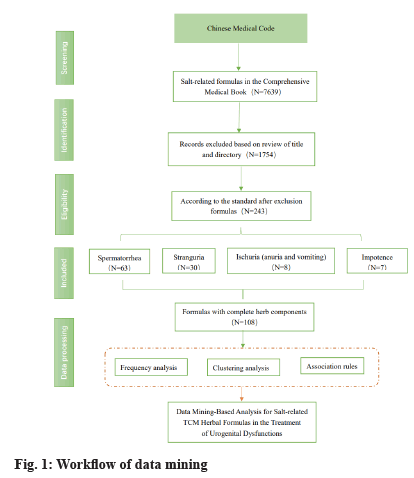
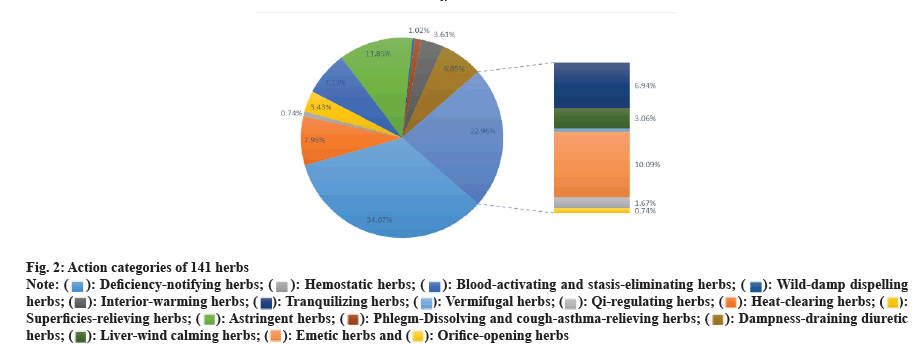
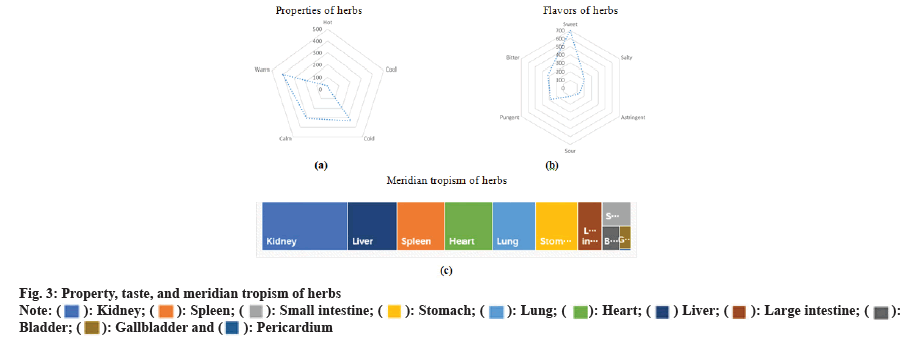
 ): Kidney; (
): Kidney; ( ): Spleen; (
): Spleen; ( ): Small intestine; (
): Small intestine; ( ): Stomach; (
): Stomach; ( ): Lung; (
): Lung; ( ): Heart; (
): Heart; ( ) Liver; (
) Liver; ( ): Large intestine; (
): Large intestine; ( ):
Bladder; (
):
Bladder; ( ): Gallbladder and (
): Gallbladder and ( ): Pericardium
): Pericardium